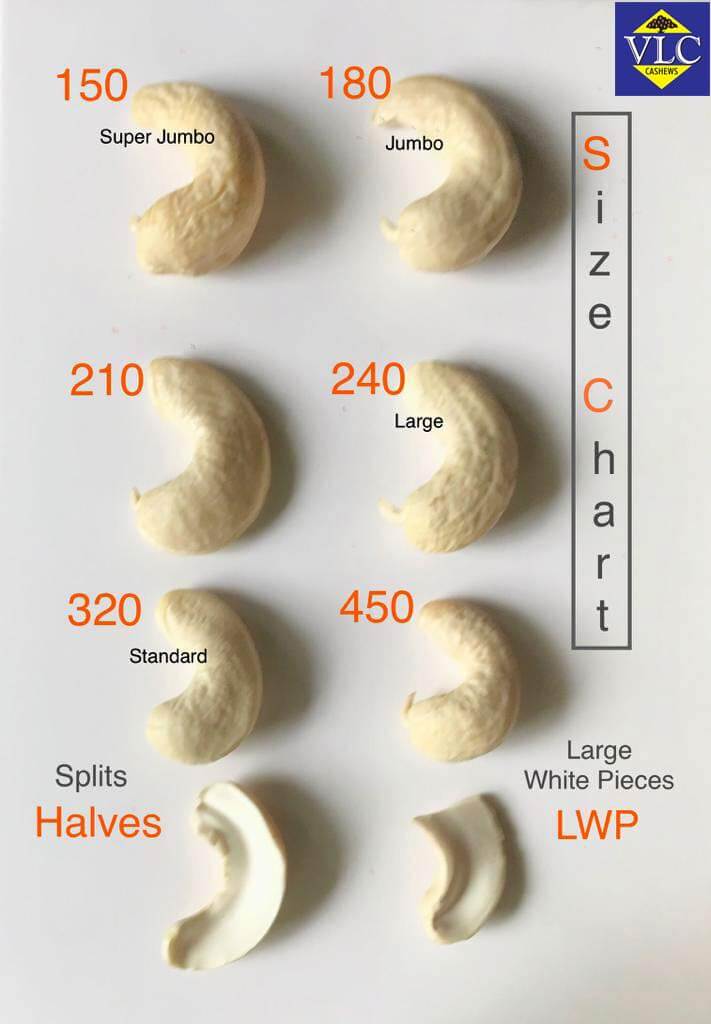Cashews are a kidney-shaped seed sourced from the cashew tree — a tropical tree native to Brazil but now cultivated in various warm climates across the world.
Cashews are low in sugar and rich in fiber, heart-healthy fats, and plant protein. They’re also a good source of copper, magnesium, and manganese — nutrients important for energy production, brain health, immunity, and bone health.
Cashews are rich in carotenoids and polyphenols, two categories of antioxidants that may help reduce inflammation and offer protection from disease.
Cashews appear to provide fewer calories than once thought. Their rich fiber and protein content can help reduce hunger and increase feeling full. Put together, all of these factors may help you lose excess weight.
1. W-180
At the top of the list is the W-180 because this is the largest available.
The different types of cashew nuts are really like grades.
The W-180 is sometimes referred to as the King of cashews.
This is because of its size and the fact that it remains wholly intact when sold.

2. W- 210/240
The W-210 is going to be smaller than the W-180.
These are still very large nuts.
The W-210 cashews are often referred to as Jumbo size.
They fall slightly behind the King, but these are still known and recognized as being very large cashews.
Moving down another step in size, you will come across the W-240.
These are the mid-grade cashew known as the standard size cashew.
These cashews are very commonly seen in nut mixes where the cashew is not the star of the show.
They still look good, they are not nearly as big as a King or Jumbo cashew.


3. W-320
The W-320 is the easiest cashew nut to find and the most widely sold and distributed.
The W-320 offers the perfect balance between size and cost, and they are what the majority of consumers are comfortable with.
The size is large enough, but the pricing makes them much more appealing to the general consumer.

4. W-450
The W-450 is the last of the whole size cashews.
The difference is size is going to be very noticeable.
The W-450 is quite popular because of their cheap pricing, and once you move down from the W-450, that is when you start talking about pieces of cashews.
If you know you want the whole cashew but don’t want to spend a lot, the W-450 is a great choice to consider.

5. Scorched
Wholes
You may also see cashews called scorched cashews.
The scorched cashews are those that are a light brown color.
The light brown cashew was roasted slightly longer than the white ones, and it results in a darker brown color.
The scorched type cashews are sometimes sold in pieces and, other times, sold in wholes as well.

Broken Pieces Cashew
Raw cashews are 5% water, 30% carbohydrates, 44% fat, and 18% protein (table). In a 100 gram reference amount, raw cashews provide 553 Calories, 67% of the Daily Value (DV) in total fats, 36% DV of protein, 13% DV of dietary fiber and 11% DV of carbohydrates. Cashews are rich sources (20% or more of the DV) of dietary minerals, including particularly copper, manganese, phosphorus, and magnesium (79-110% DV), and of thiamin, vitamin B6 and vitamin K (32-37% DV) Iron, potassium, zinc, and selenium are present in significant content (14-61% DV) Cashews (100 grams, raw) contain 113 milligrams (1.74 gr) of beta-sitosterol.
The grade of the cashew will tell you things about the coloring, the size, and the pricing as well.
In total, there are 33 different grades of cashew nuts, but only 26 are available for people to purchase.
Why do people love us?

Direct from Production Houses

Customized Packaging as per Requirement
(Bubble Packing, Tin Packing, Small Pouch)






